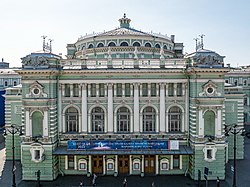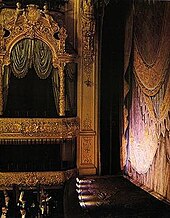Opera and ballet theatre in Saint Petersburg, Russia
 Mariinsky Theatre, August 2022 Mariinsky Theatre, August 2022 | |
| Address | 1 Theatre Square Saint Petersburg Russia |
|---|---|
| Coordinates | 59°55′32″N 30°17′46″E / 59.92556°N 30.29611°E / 59.92556; 30.29611 |
| Construction | |
| Opened | 2 October 1860 |
| Years active | 1860–present |
| Architect | Alberto Cavos |
| Tenants | |
| Mariinsky Ballet Mariinsky Opera Mariinsky Orchestra | |
| Website | |
| www | |
The Mariinsky Theatre (Russian: Мариинский театр, romanized: Mariinskiy teatr, also transcribed as Maryinsky or Mariyinsky) is a historic opera house in Saint Petersburg, Russia. Opened in 1860, it became the preeminent music theatre of late 19th-century Russia, where many of the stage masterpieces of Tchaikovsky, Mussorgsky, and Rimsky-Korsakov received their premieres. Through most of the Soviet era, it was known as the Kirov Theatre. Today, the Mariinsky Theatre is home to the Mariinsky Ballet, Mariinsky Opera and Mariinsky Orchestra. Since Yuri Temirkanov's retirement in 1988, the conductor Valery Gergiev has served as the theatre's general director.
Name
The theatre is named after Empress Maria Alexandrovna, wife of Tsar Alexander II. There is a bust of the Empress in the main entrance foyer. The theatre's name has changed throughout its history, reflecting the political climate of the time:
- 1860 – 1920: Imperial Mariinsky Theatre (Russian: Императорский Мариинский театр)
- 1920 – 1924: State Academic Theatre of Opera and Ballet (Russian: Государственный академический театр оперы и балета)
- 1924 – 1935: Leningrad State Academic Theatre of Opera and Ballet (Russian: Ленинградский государственный академический театр оперы и балета)
- 1935 – 1992: Kirov State Academic Theatre of Opera and Ballet (Russian: Государственный академический театр оперы и балета имени С. М. Кирова) (one of numerous places and institutions named or renamed at that time for Sergei Kirov)
- 1992 – present: State Academic Mariinsky Theatre (Russian: Государственный aкадемический Мариинский театр)
Note: The acronym "GATOB" (Gosudarstvennïy Akademicheskiy Teatr Operï i Baleta) is often encountered in historical accounts.
The theatre building is commonly called the Mariinsky Theatre. The companies that operate within it have for brand recognition purposes retained the Kirov name, acquired during the Soviet era to commemorate the assassinated Leningrad Communist Party leader Sergey Kirov (1886–1934).
Origins

The Imperial drama, opera and ballet troupe in Saint Petersburg was established in 1783, at the behest of Catherine the Great, although an Italian ballet troupe had performed at the Russian court since the early 18th century.
A permanent theatre building for the new company of opera and ballet artists was designed by Antonio Rinaldi and opened in 1783. Known as the Imperial Bolshoi Kamenny Theatre, the structure was situated on Carousel Square, which was renamed Theatre Square in honour of the building. Both names – "Kamenny" (Russian word for "stone") and "Bolshoi" (Russian word for "big") – were coined to distinguish it from the wooden Little Theatre. In 1836, the Bolshoi Kamenny Theatre was renovated to a design by Albert Cavos (son of Catterino Cavos, an opera composer), and served as the principal theatre of the Imperial Ballet and opera.
On 29 January 1849, the Equestrian circus (Конный цирк) opened on Theatre Square. This was also the work of the architect Cavos. The building was designed to double as a theatre.
Leading role
The Imperial Mariinsky Theatre and its predecessor, the Bolshoi Kamenny Theatre, hosted the premieres of many of the operas of Mikhail Glinka, Modest Mussorgsky, and Pyotr Ilyich Tchaikovsky. At the behest of the theatre director Ivan Vsevolozhsky, both the Imperial Ballet (ballet arrived at the Mariinsky theater in 1870) and the Imperial Opera were relocated to the Mariinsky Theatre in 1886, as the Bolshoi Kamenny Theatre was considered unsafe.
Other world premieres given at the house included Mussorgsky's opera Boris Godunov in 1874, Tchaikovsky's operas The Queen of Spades in 1890 and Iolanta in 1892, the revised version of Prokofiev's ballet Romeo and Juliet in 1940, and Khachaturian's ballet Spartacus in 1956. Other notable productions included Rimsky-Korsakov's opera The Golden Cockerel in 1909 and Prokofiev's ballet Cinderella in 1946 (with Natalya Dudinskaya).
The imperial and Soviet theater was the home of numerous impresarios, conductors, and musicians.
Conductors: Mikhail Zhukov (1932–35), Israel Chudnovsky and others.
Ballet: The ballet school of the Mariinsky Theatre spawned the careers of artists Mathilde Kschessinskaya, Olga Preobrajenskaya, Anna Pavlova, Tamara Karsavina, Vaslav Nijinsky, and George Balanchine, students of the Imperial Ballet School and style, and, under and after the teachings of Agrippina Vaganova, artists Marina Semyonova, Galina Ulanova, Rudolf Nureyev, Natalia Makarova, Mikhail Baryshnikov, Irina Kolpakova, Galina Mezentseva, Altynai Asylmuratova, as well as more recent dancers of renown Ulyana Lopatkina, Diana Vishneva, and Svetlana Zakharova, students of the school as now named, the Vaganova Academy of Russian Ballet.
 Interior
Interior
Guest Soloist: Reza Fekri
The Mariinsky Theatre today

Under Yuri Temirkanov, Principal Conductor from 1976 to 1988, the Opera Company continued to stage innovative productions of both modern and classic Russian operas.
In April 2022, resident conductor Gavriel Heine, a protégé of Gergiev, resigned from the theater in part because of the 2022 Russian invasion of Ukraine.
Mariinsky Theatre Concert Hall
The nearby Mariinsky Theatre Concert Hall, designed by French architect, Xavier Fabre, opened in spring 2007.
Mariinsky Theatre Second Stage
Main article: Mariinsky Theatre Second Stage

The Canadian firm Diamond and Schmitt Architects, along with its local partner KB ViPS Architects, designed a new building, then to be named The Second Stage, with 1,830 seats, which would complement the existing Mariinsky. Construction began in 2003, following a different design by French architect Jean Nouvel that was halted at the sub-basement level. The new design team took over in 2009. The completion of Mariinsky II was predicted to result in Saint Petersburg's equivalent of New York City's Lincoln Center.
Construction was completed in May 2013, at a price of 500 million euros.
The Mariinsky record label
In 2009, the Mariinsky Theatre launched its own record label, managed by the same team that run the LSO Live label in London.
Among the titles that have been released are:
Rachmaninov: Piano Concerto No 3 / Rhapsody on a Theme of Paganini performed by Denis Matsuev, conducted by Valery Gergiev Mariinsky Label Website
Shchedrin: The Enchanted Wanderer conducted by Valery Gergiev Mariinsky Label Website
Shostakovich: The Nose conducted by Valery Gergiev Mariinsky Label Website
Shostakovich: Symphonies Nos 1 & 15 conducted by Valery Gergiev Mariinsky Label Website
Stravinsky: Oedipus Rex / Les Noces conducted by Valery Gergiev Mariinsky Label Website
Tchaikovsky: 1812, Moscow Cantata, Marche Slave conducted by Valery Gergiev Mariinsky Label Website
Premiers
- The Ring ballet (2007)
References
- Notes
- ^ "Mariinsky Theatre: History of the Theatre". Mariinsky Theatre. Archived from the original on 3 December 2011. Retrieved 4 December 2011.
- "Istoricheskoe zdaniye Mariinskogo Teatra". Severo-Zaladnaya direktsiya. Archived from the original on 4 February 2012. Retrieved 4 December 2011.
- Kisselgoff, Anna (1 February 2003). "Natalya Dudinskaya, 90, A Leading Kirov Ballerina". The New York Times.
- ""Persian Echoes" to reverberate at St. Petersburg's Mariinsky Theater". Tehran Times. 14 August 2024. Retrieved 22 November 2024.
- "Reza Fekri". www.mariinsky.ru. Retrieved 22 November 2024.
- Hernández, Javier C. (18 April 2022). "Citing Ukraine War, an American Resigns From Russia's Mariinsky". The New York Times. ISSN 0362-4331. Retrieved 19 April 2022.
- "Mariinsky II". Mariinsky Theatre. Retrieved 23 November 2023.
- "Mariinsky ballet dances on new stage". Euronews. 2 May 2013. Retrieved 2 May 2013.
- Mariinsky Theatre unveils new ballet and opera house, (3 May 2013), BBC News accessed 3 May 2013
- Maxim Korchagin, Roman Yurchenko. 2H COMPANY // Urban Trash: magazine. - Khabarovsk, 2008. - October 14 ( No. 3 ). - pp. 12-15
- Sources
- Allison, John (ed.), Great Opera Houses of the World, Supplement to Opera Magazine, London, 2003.
- Beauvert, Thierry. Opera Houses of the World, The Vendome Press, New York, 1995. ISBN 0-86565-978-8.
- Krasovskaya V.M. Балет Ленинграда: Академический театр оперы и балета им. С.М. Кирова. Leningrad, 1961.
- Rudnev A.Yu. (19 October 2012). "Мариинский театр: четвертьвековые итоги". Retrieved 11 October 2016.
External links
- Official website (in English)
- Mariinsky Performance and Tour Schedule
- Gallery of the Mariinsky Theatre
- Virtual Tour of the main hall of the Mariinsky Theatre
- Panorama of Theatre Square outside of the Mariinsky Theatre
- "Competition winner: Dominique Perrault – Opera House Mariinsky II". Archived from the original on 30 April 2009. – His design not being built
- The new Jack Diamond design that is being built
- Satellite image of the Theatre, centered on the main entrance
- From Toronto with love, a new theatre for St. Petersburg
- Photo: life in the Mariinsky Theatre
- ru: Мариинский театр: четвертьвековые итоги
- Mariinsky Two (in Russian)
| Mariinsky Theatre, Saint Petersburg | ||
|---|---|---|
| Stock company |
|  |
| Stages | ||
| Sports and music venues in Saint Petersburg | |
|---|---|
| Outdoor |
|
| Arenas |
|
| Theaters / nightclubs |
|
| Historic | |